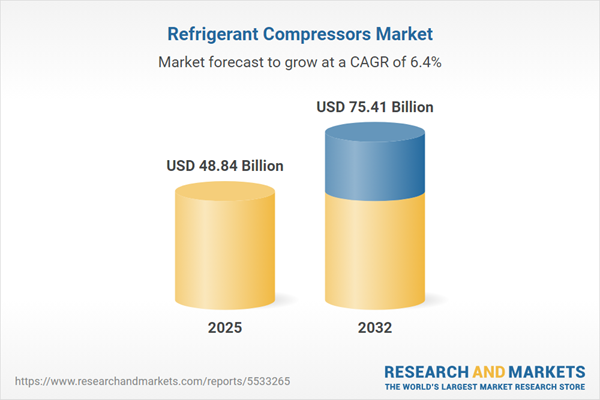Speak directly to the analyst to clarify any post sales queries you may have.
The refrigerant compressors market is transforming as organizations confront emerging compliance mandates, evolving sourcing dynamics, and growing sustainability targets. As leaders adjust strategies for optimal risk management, timely intelligence is vital for guiding procurement, investment, and technology adoption decisions.
Market Snapshot: Refrigerant Compressors Market Size and Outlook
The global refrigerant compressors market is forecast to expand steadily, with its value projected to grow from USD 45.89 billion in 2024 to USD 48.84 billion by 2025, and is expected to reach USD 75.41 billion by 2032, reflecting a CAGR of 6.40%. Growth is driven by the increasing need for advanced, energy-efficient solutions serving commercial, industrial, and residential cooling requirements. Innovative use of new materials and integrated digital controls is enabling organizations to improve efficiency, reduce environmental impact, and comply with complex regulatory frameworks. These advancements help procurement leaders balance capital outlays, compliance needs, and lifecycle maintenance priorities for optimal asset performance.
Scope & Segmentation: Strategic Refrigerant Compressors Market Opportunities
This report equips procurement and C-suite executives with actionable analysis by mapping out critical market segments and key technological trends influencing sourcing and investment planning:
- Compressor Types: Centrifugal, reciprocating, rotary including screw and vane, and scroll compressors allow companies to tailor equipment to specific operational and end-use environments, from large-scale manufacturing to high-performing appliances.
- Drive Types: Diesel, electric, and gas-powered variants enable procurement teams to align compressor choices with site-specific power sources and flexibility, supporting project continuity even with local utility variations.
- Refrigerant Types: CFCs, HCFCs, HFCs, ammonia, CO2, and hydrocarbon refrigerants offer a diverse range of compliance pathways and sustainability profiles, supporting company pledges to reduce emissions and adapt to stricter regulations.
- Capacity Range: High, medium, and low capacity models facilitate the right match from heavy industrial processes to compact residential applications, ensuring resource allocation aligns with productivity targets.
- Distribution Channels: OEM and aftermarket supply routes help organizations streamline purchase decisions and maintain cost-efficient service schedules throughout product life cycles.
- End Use Industries: Solutions target commercial refrigeration, process cooling, and residential air conditioning, with configurations engineered to enhance reliability and business continuity.
- Regional Coverage: The analysis spans the Americas, Europe, Middle East & Africa, and Asia-Pacific, capturing local regulatory drivers, investment climates, and emerging market strategies essential to global and regional growth plans.
- Company Coverage: In-depth profiles of Danfoss A/S, Copeland (Emerson Electric Co.), Bitzer SE, Tecumseh Products Company LLC, Embraco (Nidec Corporation), Carlyle Compressor Company, Johnson Controls International plc, Officine Mario Dorin S.p.A., Huayi Compressor Co., Ltd., and Kulthorn Kirby Public Co., Ltd. highlight current approaches to compliance and technology adaptation across the value chain.
Key Takeaways for Senior Decision Makers
- Optimization of product lines and workflows enables organizations to stay responsive to evolving regulatory demands, ensuring that strategic plans remain resilient and adaptable.
- Improvements in drive and material technologies contribute to increased equipment longevity, delivering value for both new and retrofit installations across business operations.
- Disruptions in supply chains reinforce the need for diversified sourcing and enhanced local supplier relationships, providing greater certainty in project execution and risk mitigation.
- Advanced compressor features now emphasize energy savings, lower emissions, and reduced noise, making them more attractive for both operators and stakeholders seeking compliance and workplace satisfaction.
- Deploying predictive analytics and digital diagnostics allows maintenance strategies to shift from reactive to preventive, improving uptime and boosting asset returns for a range of applications.
Tariff Impact: Navigating US Policy and Global Supply Chain Response
In response to possible changes in US tariff policy, manufacturers are increasingly focusing on regional and domestic sourcing strategies. This approach helps safeguard operations against abrupt regulatory changes, promoting supply chain stability and reduced project risk.
Research Methodology & Data Sources
The findings in this refrigerant compressors market analysis are grounded in rigorous research, including regulatory reviews, patent analysis, and monitoring of technological advances. Expert interviews with OEMs, supply chain stakeholders, and end users, along with targeted surveys, provide credible and current sector insights.
Why This Report Matters: Strategic Refrigerant Compressors Market Benefits
- Facilitates the identification of market opportunities and risks at both segment and geographic levels, equipping leaders to direct resources where they are most effective.
- Supports agile responses to regulatory and supply chain developments through targeted analytics and scenario planning relevant for procurement, operations, and compliance leaders.
- Enables senior decision-makers to refine expansion and operational strategies, maintaining a competitive advantage in a rapidly evolving market.
Conclusion
This analysis provides senior leadership with a clear understanding of refrigerant compressor sector trends and actionable intelligence to support effective sourcing, investment, and compliance strategy decisions.
Additional Product Information:
- Purchase of this report includes 1 year online access with quarterly updates.
- This report can be updated on request. Please contact our Customer Experience team using the Ask a Question widget on our website.
Table of Contents
3. Executive Summary
4. Market Overview
7. Cumulative Impact of Artificial Intelligence 2025
Companies Mentioned
The companies profiled in this Refrigerant Compressors market report include:- Danfoss A/S
- Copeland (Emerson Electric Co.)
- Bitzer SE
- Tecumseh Products Company LLC
- Embraco (Nidec Corporation)
- Carlyle Compressor Company
- Johnson Controls International PLC
- Officine Mario Dorin S.p.A.
- Huayi Compressor Co., Ltd.
- Kulthorn Kirby Public Co., Ltd.
Table Information
| Report Attribute | Details |
|---|---|
| No. of Pages | 180 |
| Published | November 2025 |
| Forecast Period | 2025 - 2032 |
| Estimated Market Value ( USD | $ 48.84 Billion |
| Forecasted Market Value ( USD | $ 75.41 Billion |
| Compound Annual Growth Rate | 6.4% |
| Regions Covered | Global |
| No. of Companies Mentioned | 11 |









